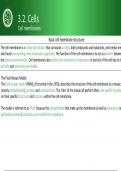3.2. Cells
Cell membranes:
Basic cell membrane structure:
The cell membrane is a mainly lipid bilayer that surrounds all cells, both prokaryotic and eukaryotic, and similar me
also found surrounding many eukaryotic organelles. The function of the cell membrane is to act as a barrier betwee
the external environment. Cell membranes also control the movement of substances in and out of the cell due to th
partially and selectively permeable.
The Fluid Mosaic Model:
The fluid mosaic model (FMM), first coined in the 1970s, describes the structure of the cell membrane as a mosaic
(mainly phospholipids), proteins and carbohydrates. The ‘tiles’ of the mosaic all perform their own specific function
on their specific structures and locations within the cell membrane.
The model is referred to as ‘fluid’ because the phospholipids that make up the membrane (as well as cholesterol an
peripheral proteins) constantly move within the membrane.
, 3.2. Cells
Cell membranes:
Basic cell membrane structure:
The Fluid Mosaic Model:
The fluid mosaic model (FMM), first coined in the 1970s, describes the structure of the cell membrane as a mosaic
(mainly phospholipids), proteins and carbohydrates. The ‘tiles’ of the mosaic all perform their own specific function
on their specific structures and locations within the cell membrane.
, 3.2. Cells
Cell membranes:
Basic cell membrane structure:
The Fluid Mosaic Model:
Phospholipids:
Phospholipids make up the majority of the fluid mosaic membrane, forming a
barrier to the movement of dissolved substances.
The phospholipid bilayer (two-layers of phospholipids) forms automatically, as phospholipids have a hydrophilic reg
phosphate-glycerol head) and hydrophobic region (the fatty acid tails).
The hydrophilic regions naturally orientate themselves towards watery environments, such as the cytoplasm and e
fluid (ECF), making them face outwards while the hydrophobic tails point inwards towards each other to form a hyd
core in the membrane.
This hydrophobic centre means that water-soluble and dissolved substances (e.g. ions and polar molecules) can’t simply pass thro
membrane, while small, non-polar molecules (e.g. carbon dioxide) can diffuse straight through.
Despite being polar molecules, phospholipids (as well as other lipids like triglycerides) are able to pass through the phospholipid b
diffusion, because the membrane is lipid soluble. This allows for monoglycerides and fatty acids to enter the epithelial cells of the
diffusion during their absorption process.




